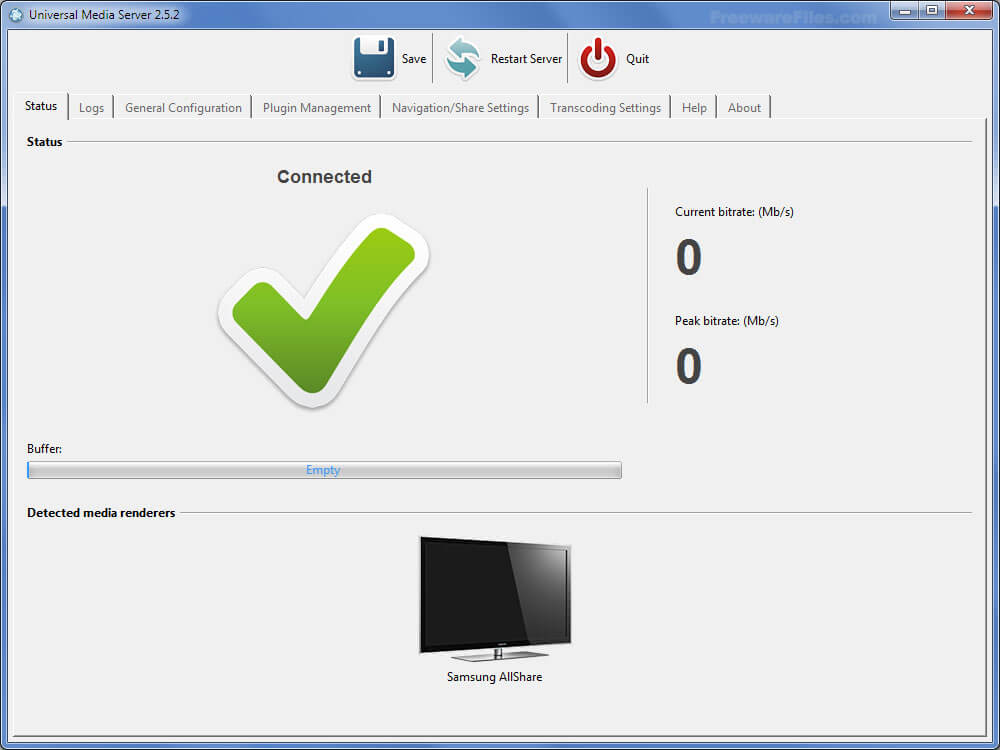

- #Universal media server installation guide install
- #Universal media server installation guide 64 Bit
- #Universal media server installation guide update
- #Universal media server installation guide Pc
- #Universal media server installation guide ps3
On your PC, install a VNC client (TighVNC or RealVNC worked for me). Because the free VNC clients do not provide encryption, you must disable encryption on the server from the command line: Uncheck: You must confirm each access to this machine Menu -> All Applications -> Desktop Sharing ->Ĭheck: Allow other users to control your desktop Menu -> System Settings -> Screen Locker -> uncheck both ckeckboxes


#Universal media server installation guide update
Menu -> Administration -> Update Manager -> install pending updatesĪlternatively, you can run the following command from a terminal: Once the installation has completed, take the following steps. Insert the USB disk and press F10 for boot options.Īfter Linux has started, click on the icon "Install Linux".
#Universal media server installation guide 64 Bit
In the examples below, Mint Cinnamon is used.ĭownload the 64 bit 'iso' file and create a bootable USB disk using Universal-USB-Installer. You can use at least: Mint Cinnamon, Mint MATE or Ubuntu. In the BIOS you can also adapt the fan speed to a lower value. Next boot the barebone PC, press F2 for Setup and next F7 to install the update. 2.5 inch harddisk (e.g. WD Red WD10JFCX 1 TB)įor installation you also need to attach a (wired) network, mouse, keyboard and monitor.ĭownload the '.bio' file and put it on a USB stick. You can reduce the fan speed in the BIOS and/or have place it in a cabinet. This barebone is not completely silent because it has a fan. cheap one): Intel NUC Kit DN2820FYKH with Celeron processor. Nowadays it is cheaper to use a Raspberry PI and attach an SSD drive (see my other page). Videos and pictures are played using the XBMC program (also controllable from an app). You can control the Logitch Media Server by an app on your smartphone or tablet.

#Universal media server installation guide Pc
It replaces my Windows PC that was running Logitch Media Server and the Squeezebox receiver. This barebone is connected to a USB DAC (for high quality audio) and to the TV (for videos and pictures). This page describes how I have build my media server using a barebone PC (Intel NUC). Transcoding is accomplished through packages from AviSynth, FFMpeg, MEncoder, and VLC.Building a Media Server using an Intel NUC It streams and transcodes multimedia files over a network connection to the rendering device, ensuring that a supported rendering device will receive the content in a format supported by the device. It allows streaming of media files to a wide range of devices including video game consoles, smart TVs, smartphones, and Blu-ray players.
#Universal media server installation guide ps3
It originated as a fork of PS3 Media Server. Universal Media Server is a DLNA-compliant UPnP media server.AC Ryan PlayOn!HD, Sony Anycast, Apple iPad, Apple iPhone, Apple iPod, Apple TV, Asus O!Play, BlackBerry, Boxee, Brite-view CinemaTube, Cambridge Audio BD Players, DirecTV HR, D-Link DSM, Freebox, Freecom MusicPal, Google Android, Google Chromecast, Hama Internet Radio, LG Smart TV Upgrader, LG TVs, Logitech Squeezebox, Microsoft Xbox 360, Microsoft Xbox One, Miracast M806, Netgear NeoTV, Nokia N900, Onkyo A/V Receivers, OPPO Blu-ray players, Panasonic Sound Systems, Panasonic TVs, Philips Streamium, Philips TVs, Pioneer Kuro, Popcorn Hour, Realtek media players, Roku 3, Samsung smart phones, Samsung TVs, Sharp TVs, Showtime, Sony A/V receivers, Sony Blu-Ray players, Sony Network Media Players, Sony PlayStation 3, Sony PlayStation 4, Sony PlayStation Vita, Sony smart phones, Sony TVs, Telstra T-Box, Technisat S1+, VideoWeb TV, Vizio Smart TVs, Western Digital WD TV Live, XBMC Media Center, Xtreamer, Yamaha A/V receivers (en).dbr:Comparison_of_UPnP_AV_media_servers.Enhancements over its predecessor, PS3 Media Server, include web interface support for non-DLNA devices, more supported renderers, automatic bit rate adjustment, and many other transcoding improvements. Transcoding is accomplished through packages from AviSynth, FFMpeg, MEncoder, and VLC.


 0 kommentar(er)
0 kommentar(er)
